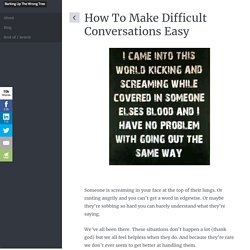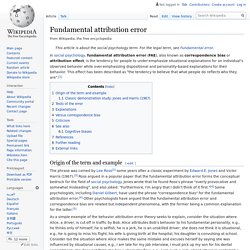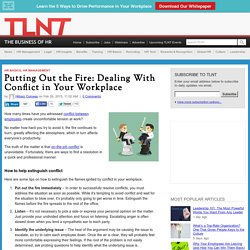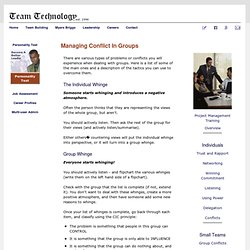

Conflict Resolution - Resolving conflict rationally and effectively - Leadership training from MindTools. Conflict is an inevitable part of work.

We've all seen situations where people with different goals and needs have clashed, and we've all witnessed the often intense personal animosity that can result. As you'll learn in this article and video, the fact that conflict exists, however, is not necessarily a bad thing. When you resolve it effectively, you can also eliminate many of the hidden problems that it brought to the surface. Conflict Information Consortium. Journal of Conflict Resolution. Conflict Resolution Network. How To Make Difficult Conversations Easy. Someone is screaming in your face at the top of their lungs.

Or ranting angrily and you can’t get a word in edgewise. Or maybe they’re sobbing so hard you can barely understand what they’re saying. We’ve all been there. These situations don’t happen a lot (thank god) but we all feel helpless when they do. And because they’re rare we don’t ever seem to get better at handling them. Problem is, these moments are often critical because they’re usually with people we care about. Fundamental attribution error. In social psychology, fundamental attribution error (FAE), also known as correspondence bias or attribution effect, is the tendency for people to under-emphasize situational explanations for an individual's observed behavior while over-emphasizing dispositional and personality-based explanations for their behavior.

This effect has been described as "the tendency to believe that what people do reflects who they are".[1] Origin of the term and example[edit] As a simple example of the behavior attribution error theory seeks to explain, consider the situation where Alice, a driver, is cut off in traffic by Bob. Alice attributes Bob's behavior to his fundamental personality, e.g., he thinks only of himself, he is selfish, he is a jerk, he is an unskilled driver; she does not think it is situational, e.g., he is going to miss his flight, his wife is giving birth at the hospital, his daughter is convulsing at school. Classic demonstration study: Jones and Harris (1967)[edit] Conflict Strategies for Nice People. Do you value friendly relations with your colleagues?

Are you proud of being a nice person who would never pick a fight? Unfortunately, you might be just as responsible for group dysfunction as your more combative team members. That’s because it’s a problem when you shy away from open, healthy conflict about the issues. If you think you’re “taking one for the team” by not rocking the boat, you’re deluding yourself. Managing Conflict with Your Boss. Managing Conflict with Peers. This guidebook is available for eBook purchase and download from Apple's iBookstore; Amazon's Kindle; Google eBooks; Sony iStore, and other reputable distributors of eContent.

A Free Membership That Supports Your Leadership Needs - Join and Save Did you know that you can join the open and always-free myCCL at no cost and get a discount on this CCL Press Publication? CCL provides myCCL members with a 5% discount on CCL Press Publications like this just for being a member. Membership is complimentary in order to support our non-profit goal of connecting a world community of leaders and providing the best in leadership and leadership development for the benefit of societies world-wide. Managing Conflict with Direct Reports.
This guidebook is available for eBook purchase and download from Apple's iBookstore; Amazon's Kindle; Google eBooks; Sony iStore, and other reputable distributors of eContent.

A Free Membership That Supports Your Leadership Needs - Join and Save Did you know that you can join the open and always-free myCCL at no cost and get a discount on this CCL Press Publication? CCL provides myCCL members with a 5% discount on CCL Press Publications like this just for being a member. Membership is complimentary in order to support our non-profit goal of connecting a world community of leaders and providing the best in leadership and leadership development for the benefit of societies world-wide.
4 Ways Leaders Effectively Manage Employee Conflict. Putting Out the Fire: Dealing With Conflict in Your Workplace. How many times have you witnessed conflict between employees create uncomfortable tension at work?

No matter how hard you try to avoid it, the fire continues to burn, greatly affecting the atmosphere, which in turn affects everyone’s productivity. The truth of the matter is that on-the-job conflict is unavoidable. Fortunately, there are ways to find a resolution in a quick and professional manner. How to help extinguish conflict Here are some tips on how to extinguish the flames ignited by conflict in your workplace.
Put out the fire immediately – In order to successfully resolve conflicts, you must address the situation as soon as possible. Three Leadership Steps to Defuse Tense Situations - Rosabeth Moss Kanter. By Rosabeth Moss Kanter | 10:23 AM May 2, 2011 How do leaders maintain morale and momentum when members of their team are close to collapsing in frustration over the obstacles they face?

Perhaps the issue is angry customers whose questions are hard to answer, or uncooperative peers from other groups who cause logjams and delay decisions. Team members might grumble and complain, or they might simply appear worn down, ready to drop the ball. Sometimes leaders are frustrated or annoyed themselves. This is already taking too much time. Before tensions get worse, leaders should turn down the heat and get everyone back on track.
Step 1: Empathize. Step 2: Offer support. Step 3: Invoke higher principles. Listen, support, and uplift. Tackle Conflicts with Conversation - Judith E. Glaser. By Judith E.

Glaser | 11:00 AM February 11, 2014 My husband and I got married after only three dates. Managing Conflict Effectively Builds Strength. Managing Conflict in Groups. Divide a flipchart into two, vertically.

Write -ves at the top of the left column and +ves at the top of the right column. Ask (once and only once) the group to suggest the -ves of this course of action. Flipchart the responses. Then ask the group to suggest any +ves they can think of. As the group are in a negative frame of mind, they may need some prompting for ideas. Stating what you believe the group is thinking/feeling What conclusions they should draw from the flipchart.
Reflect and emphasise any positive conclusions expressed by someone in the group. Ultimate attribution error. The ultimate attribution error is a group-level attribution error that offers an explanation for how one person views different causes of negative and positive behavior in ingroup and outgroup members.[1] Ultimate attribution error is the tendency to internally attribute negative outgroup and positive ingroup behaviour and to externally attribute positive outgroup and negative ingroup behaviour. So in other words, ultimate attribution error arises as a way to explain an outgroup's negative behaviour as flaws in their personality, and to explain an outgroup's positive behaviour as a result of chance or circumstance. It is also the belief that positive acts performed by ingroup members are as a result of their personality, whereas, if an ingroup member behaves negatively (which is believed to be rare), it is a result of situational factors.[2] Overview[edit]
What's In It For You? Potential Pros and Cons of Conflict. The Conflict Process Flow. Conflict Escalation Stages. How to play your conflict card. Every relationship has disagreements – whether they’re with the boss, friends or your partner – but it’s how you deal with them that matters. These simple steps from the latest book in the bestselling Mind Gym series explain how you can improve your relationships by responding positively and saying sorry like you mean it Updated: 22:04 GMT, 27 December 2008 Have you ever tried to trace back a broken relationship to work out when it started to go wrong? Was it the time when you scratched his car (honestly, you could barely see it)? Or when he went on a stag weekend even though he knew you had to go to hospital?
Whatever you came up with, you’re probably wrong. Because it’s not the high drama that makes or breaks our relationships – it’s the almost imperceptible micro signals that we give out daily. The relationship may have started to go wrong months earlier when he asked: ‘Do you fancy a coffee?’ Picture the scene. Hear yourself asking:‘Do you fancy a coffee?’ Nothing. How to Keep Your Cool with Competitive People. Life isn't only about winning We have all had to deal with a competitive person at some time. Whether it's the neighbor whose holiday decorations always have to be more extravagant or the coworker who grabs the credit for every project, competitive people can provoke feelings of irritation, anxiety, or inadequacy.
Keep calm, anger can trigger a heart attack! University of Sydney research reveals that the risk of a heart attack is 8.5 times higher in the two hours following a burst of intense anger. Published in European Heart Journal: Acute Cardiovascular Care, this is the first Australian study to investigate the link between acute emotional triggers and high risk of severe cardiac episodes. "Our findings confirm what has been suggested in prior studies and anecdotal evidence, even in films -- that episodes of intense anger can act as a trigger for a heart attack," said lead author Dr Thomas Buckley, Sydney Nursing School, University of Sydney, and researcher at Royal North Shore Hospital. "The data shows that the higher risk of a heart attack isn't necessarily just while you're angry -- it lasts for two hours after the outburst. In the study, 'anger' was qualified as 5 and above on a 1-7 scale, referring to 'very angry, body tense, clenching fists or teeth, ready to burst', up to 'enraged, out of control, throwing objects'.
Relationship & Outcome Variables Influencing Conflict. Conflict Strategies for Nice People. The Pinch Model of Conflict. Documents. Resolving Partner Conflict By Dr. Kiban Turner There are few things as stressful as being in conflict with a partner. This is as true in business partnerships as it is in marriage. In both cases, people are highly vested in the relationship and interact with each other all the time. The Usual Progression Most of us like to get along with others, especially people we have chosen as business partners. Things generally go swimmingly at first. When this happens, others may make half-hearted attempts to call the individual on their behavior, usually with indirect comments. What happens next is predictable. How to Adopt a Win-Win Style for Conflict Management. Credo for my relationships - Google Search.
Steps for Resolving Team Conflict from MindTools.coms. Building Stronger Teams by Facing Your Differences. Tips for Managing Conflicts. Four Stages of Expectations Negotiation. The Start - Stop - Continue Doing Process of Communicating Expectations. Simple Questions for Improving Performance MBTI® is a trademark of the MBTI Trust Inc. (see www.myersbriggs.org). Ground Rules for Conflict Resolution. Finding Common Interests. How to Take the 'Con' Out of 'Conflict' Many business leaders don't like conflict and try to sweep it under the rug, albeit unconsciously.
Think about it. Dealing With Conflict in Your Workplace. Effective Conflict Resolution Requires Effective Emotional Intelligence Skills. Emotional Self-Management Required for Effective Conflict Resolution. By Susan David | 1:00 PM June 19, 2014 I once worked with a leader — we’ll call him Karl — who needed to have a difficult conversation with an underperforming (but key) team member. To prepare, Karl built ammunition by creating a list of the employee’s shortcomings.
He sensed that the interaction would end poorly and he felt extremely anxious about it. Workplace conflicts like this one are often unavoidable. 4 Keys To Successfully Resolving Conflicts in the Workplace. Don't Get Defensive: Communication Tips for the Vigilant. Relationship Reconciliation & Rebuilding Trust. 10 ways to…repair a broken relationship.
Repairing a Breach of Trust. How to Apologize. 3 Parts of an Apology. Apology. Changed Behavior Demonstrates Sincerity Following an Apology. Even Resolved, Sometimes Conflict Destroys Relationships. Resolving Conflict with Customers. Apologize to Your Stubborn Employees and You Won't Be Sorry. What science tells us about forgiving. At some point in our lives, we have all struggled with the wrongs or perceived wrongs that others have done to us. And being unable to forgive someone is not without its costs. The emotional pain associated with such incidents can severely limit our ability to get on with our lives and plan for the future. How to Let Go of Anger and Embrace Forgiveness. 19EmailShare This sixth article in the series comes from my friend Lynn from Back to the Garden. Learn to Forgive Others No Matter What.
Accountability Reference Card (ENGLISH) : Totally Accountable, 100% Accountability.